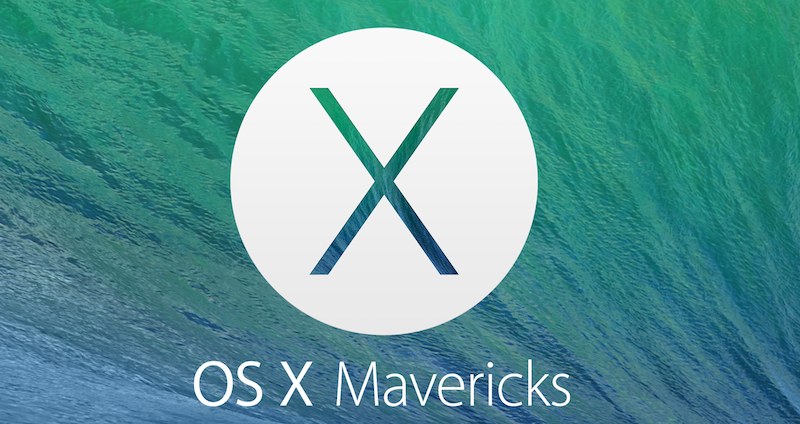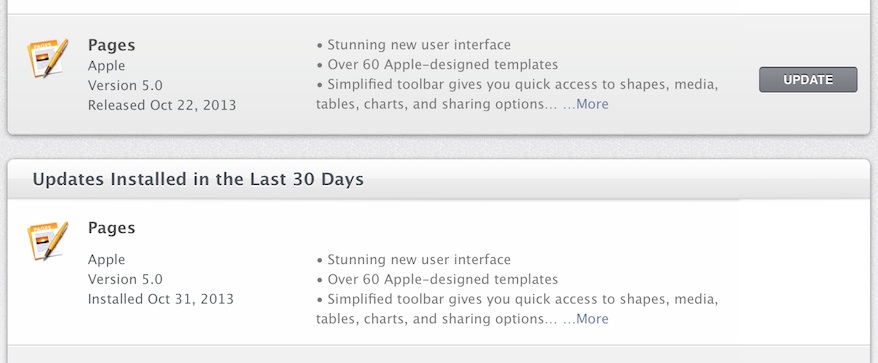A less glowing OS X Mavericks review
Most of the good things you've heard about Mavericks are true. I like a lot of what Apple has done in principle, especially the aggressive power management, tagging (hallelujah), and purging of silly decorative UI design elements that have been making me roll my eyes for a decade. These are meaningful, important improvements in how Macs work (even the “cosmetic” stuff has a serious usability dimension). I’ll give honourable mentions for multi-display support, the return of Keychain sync, and a Safari that sucks less.
So I like the idea of Mavericks. I like it a lot.
But! I cannot relate to the glowing bottom lines of every review I've read. In fact, Mavericks is the first version of OS X I have actually regretted installing. On three separately maintained and regularly used Macs, I have seen the same problems:
- unstable — which is annoying
- unresponsive — which is a bit tragic

Unstable much, Mavericks?
All the crashing, crashing, crashing is unsettling but not serious. It mostly involves individual apps going down, and at least half of it is just early adopter stuff. I had at least two critical apps that really had trouble: task manager, Things and the wonderful file-comparison tool, Kaleidoscope. They crashed pretty much constantly … until they were updated, all within a couple weeks. Exasperating, for sure, but this is not dire stuff.
And yet at times I have had as many as a dozen app crashes an hour, and my crash log is generally an order of magnitude bigger than it was under Mountain Lion. It’s the biggest spike in instability with an ugprade I’ve ever seen with an OS update … or I wouldn’t be bothering to write this cranky review.
Did I mention this is happening on all three of my Macs?
In addition to crashing, there have also been an awful lot of virtual hiccoughs, belches and ripe farts. The worst of it? App installs and updates managed by the Mac App Store have been the source of the most epic failures: dozens of stalls, cryptic failures, and user interface glitches, too many to even bother listing. But the best example is the repeat updates: after installing several apps, I was prompted to do so again. One of those prompts popped into existence as I was staring at the App Store … appearing immediately above the confirmation that I had just installed the very same thing. Very smooth, Apple.

Less responsive instead of more responsive
Dear computers: never make me wonder if you heard me.
No single thing matters more to me about a computer than its responsiveness — the fastest possible reactions to user-input. This quality is the chief reason I am an iPhone and iPad user: when you scroll text or manipulate objects on the screen, it's like they are glued to your finger. This is a Good Thing.
Modern computers, despite their powerful engines, cannot match this. The complexity of software has kept pace with computing resources, and even applications like word processors are still amazingly balky at times — even powered by a CPU that can do a billion calculations per second more than its great-great-great grandfather processor could. This is much more frustrating to most people than mere slowness. It's a psychological bummer, defeating and deflating, like cycling in a headwind. The try-it-again effect, in which we uselessly repeat clicks and commands because we're not sure if the first attempt actually did anything, pushes our buttons. Most people actually don't mind computers taking their time, as long as we know something is happening. We magnanimously accept “this is going to take a while,” but we get riled up when we can’t tell if a computer is responding at any speed. Hence the familiar distress cry of the hapless user: “Nothing’s happening!”
The typical absence of this effect on iThings is a huge part of why people like them so much, mostly without even knowing why. But it's still a problem on personal computers. Closing that gap was part of the point of the design of Mavericks. Apparently.
But I don’t really care how good Mavericks is “in principle” if it’s sluggish in practice. And — sob! — it is sluggish in practice, in my experience. On three Macs! In predictable and reproducible ways in some cases. And it appears to be because of the marquee energy management feature, App Nap, “Apple’s umbrella term for a suite of energy-saving policies applied to applications.”
A lot Mac geeks were a little worried about unintended consequences of App Nap. We wondered if it would backfire. And many of us were greatly reassured by John Siracusa's review. He explained, in detail, that the logic of App Nap is definitely to make Macs more responsive, just like iOS, by putting user input on a pedestal, the number one priority:
Right about now, you may be worried that Mavericks is going to make your Mac feel slower by starving all your applications of resources. But remember that the goal of App Nap—and Mavericks as a whole—is to extend battery life, yes, but also to improve responsiveness. Rather than picturing App Nap as an energy miser, throttling all your processes to conserve energy, think of it as a guardian, ensuring that whatever you’re currently doing has access to as many system resources as possible.
And then, later:
This time, it’s the iPad’s battery life and responsiveness that the Mac is chasing after.
Great! Music to my ears! Other users might still worry about important background processes being de-prioritized, and that likely is a problem in some cases. (An Apple developer I know well has already described exactly that: Mavericks is throttling his builds! He’s none too pleased.) But I do almost nothing in the background that has to happen fast. I’m far more interested in the speed of what’s right in front of me. And not only did Siracusa reassure me that Mavericks was built for that very specific concern, but he also reported Mavericks to be highly responsive himself (particularly in his long podcast interview with John Gruber). And John is a demanding, expert user who pulls no punches. He has often harshly criticized OS X for its worst failings, and often in perfect harmony with my own picky standards.
So I installed Mavericks. Oops.
Theory? Meet practice, and get your ass kicked
The first obvious problem was with LaunchBar. I have an exquisitely fine-tuned sense of the responsiveness of LaunchBar, an app that I have invoked literally hundreds of times every day for a decade. It has to be ready for input a split second after its invoked. After installing Mavericks, suddenly it wasn't — which was as obvious and maddening as a grain of sand in my mouth that I couldn’t spit out. Suddenly LaunchBar took too long to respond, and I would start typing before it was ready for input. The first letter or two would be missed, which would botch the job. LaunchBar is so deeply integrated into my thought processes that slowing it down is like slowing down my actual brain.
I turned off App Nap for LaunchBar (which you can't do with all apps, but it's still an option for LaunchBar for now). Problem solved. This (completely undocumented) effect is 100% reproducible with the flip of a switch. Ready-for-input delay without App Nap? Effectively zero. With App Nap? A critical several hundred milliseconds, which is a total deal-breaker. And a Mac without a highly responsive LaunchBar is nearly useless to me.
This problem may be solved by an update to LaunchBar. When fully updated for Mavericks, LB may be able to request and receive the full attention of the OS for user input, despite being normally hidden by design. I have hope. Nevertheless, it’s troubling to see such a vivid example of App Nap interference with responsiveness.
Not-so-Quick Look
There are many other similar examples: plenty of beach balling, and lots of cases of apps responding quite lazily to input, especially initial input — the first thing you ask them to do after switching to them. I have constantly found myself clicking on things once, twice, three times since installing Mavericks, because there was no reaction to the first click — the try-it-again effect, in spades. Failing to respond to initial input is very App Nap. Even though it's hard to prove it in most cases, App Nap is almost certainly the cause.
One of the worst and most consistent examples is switching to the Finder and invoking not-so-Quick Look — previewing a selected image. It’s just dog slow. You could make a pour-over coffee while my Mac rubs its eyes and blinks and says, "What?" Again, reproducible on three Macs. They all do it. Quick Look used to be quick. And it still is …for subsequent uses I usually don't need.
Update: this issue with Mavericks is widely reported. I’m definitely not the only one to notice it.
Now what?
I'm frankly baffled that other reviewers are declaring Mavericks to have “teh snappy.” Are they really having that different an experience what I'm seeing on my little fleet of Macs? It's a mystery.
All I can do is tell you what I've seen, which isn't pretty.
I imagine some of this will get better. (I think some of it already has, though it's fiendishly hard to measure.) It many cases, it really may be as simple as developers catching up and fine tuning their apps for a new way of doing things. Even Apple probably has to catch up with itself a little (it’s extremely likely that Quick Look’s quickness will come back). And there's no denying that it's all fairly subtle and technical, and the average user will probably be mostly oblivious.
And yet this is hardly just me being picky. Apple seemingly shared my views so strongly that they devoted enormous resources and innovation to addressing the same concerns in principle. Siracusa devoted thousands of words to the topic in his review — why and how Apple built Mavericks like this.
It's just that it doesn't seem to actually work. Yet? 10.9.1 cannot come soon enough.